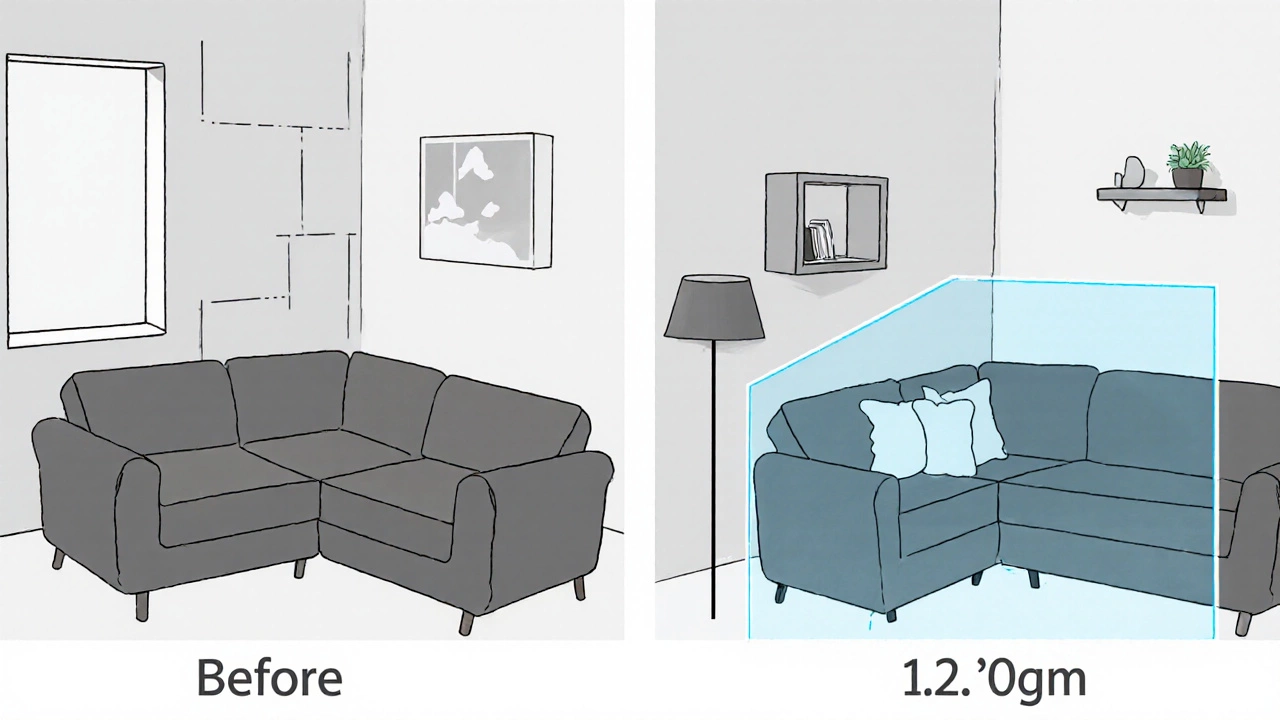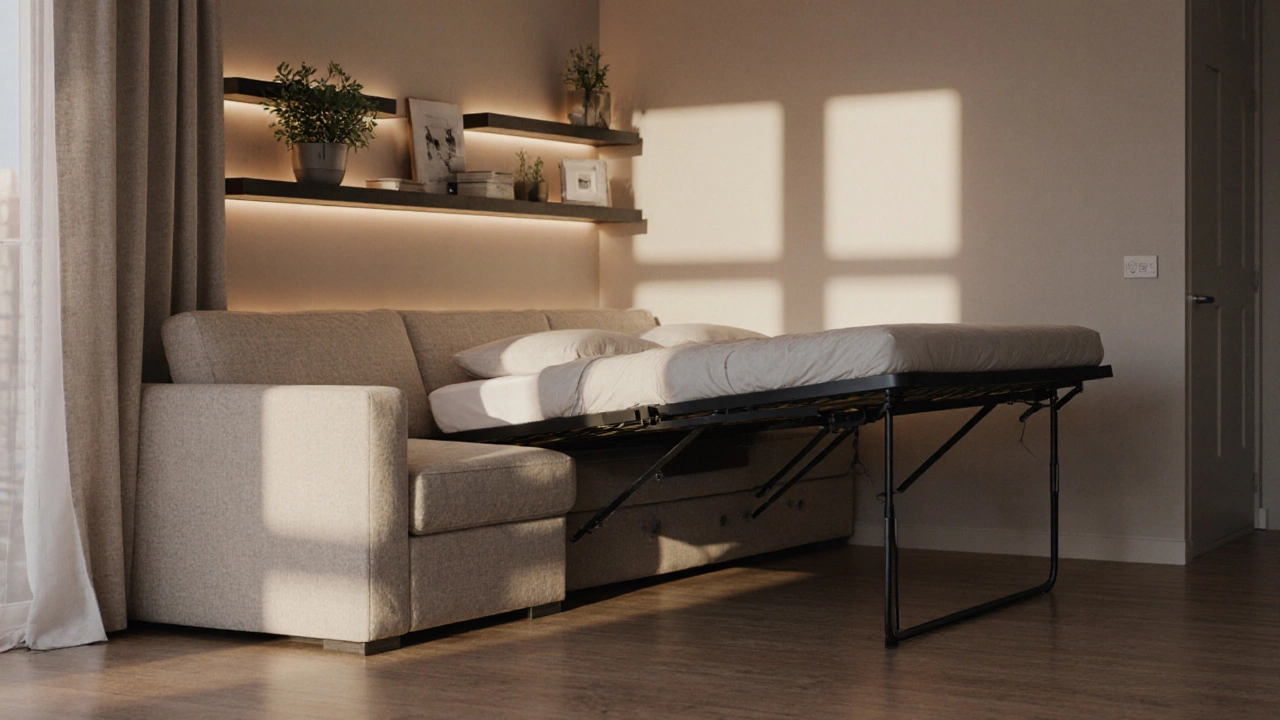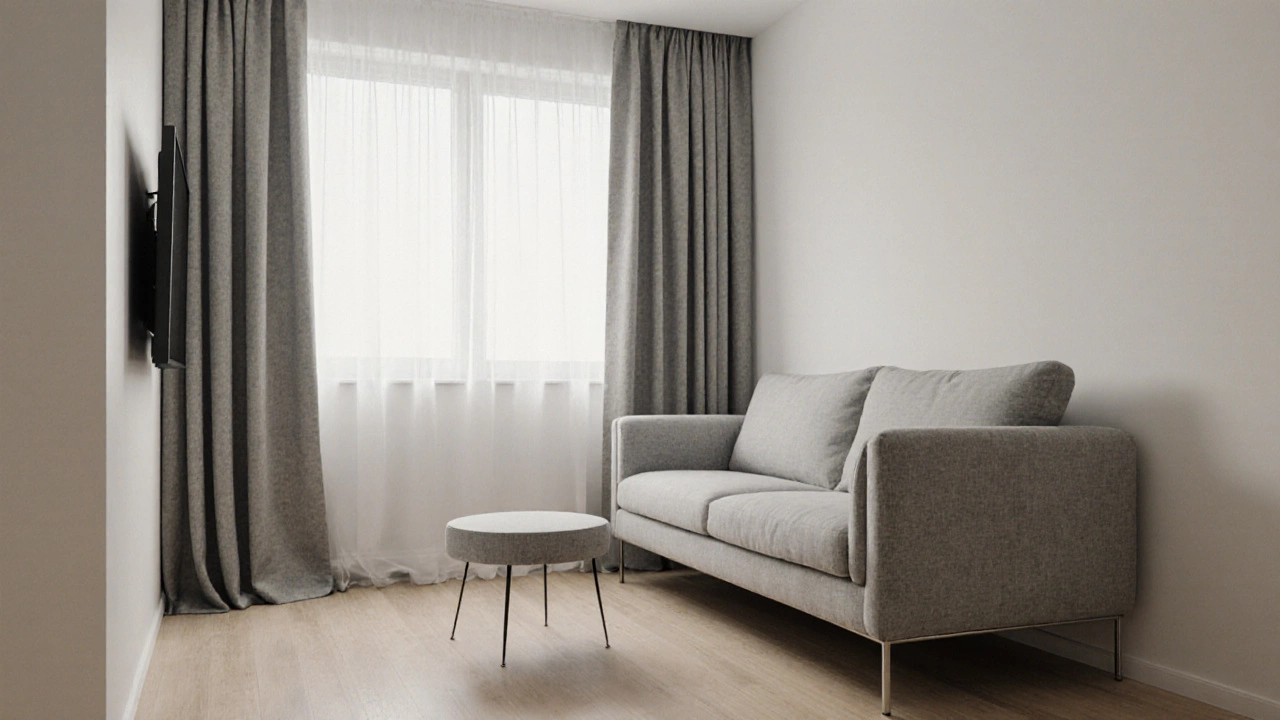Corner Sofa Size Calculator
Measure Your Space
Enter your room dimensions and sofa preferences to see if your corner sofa will fit properly.
Your space calculations will appear here.
You love the look of a corner sofa-the cozy L-shape, the extra seating, the way it hugs the room. But your living area is tight. Maybe it’s a studio apartment, a tiny urban flat, or a bedroom turned living space. You’re wondering: corner sofa in a small room-smart move or space killer?
It’s not about size, it’s about shape
A lot of people assume small rooms can’t handle large furniture. That’s not true. What matters is how the shape fits the space. A corner sofa isn’t just big-it’s designed to use corners, the part of the room most people waste. Instead of leaving empty triangles behind a straight sofa, a corner sofa fills that dead zone. That’s not taking up space-it’s reclaiming it.
Look at a typical small living room: a window on one wall, a door on another, maybe a radiator or electrical outlet blocking the perfect sofa spot. A straight sofa sits in the middle of the longest wall, leaving awkward gaps on either side. A corner sofa tucks neatly into the junction of two walls. Now you’ve got a defined seating area without needing extra floor space.
Measure before you buy-really measure
Don’t just guess. Use a tape measure. Write down the exact width, depth, and height of the room. Then measure the doorways, hallways, and stairwells. A corner sofa that looks perfect in a catalog might not fit through your front door.
Here’s what to check:
- Doorway width: Most standard doors are 76-80 cm wide. If your sofa’s largest piece is wider than that, you’re in trouble.
- Turn radius: Can the sofa sections be carried in separately? Some corner sofas come in two or three pieces. That’s a lifesaver in tight spaces.
- Clearance around the sofa: Leave at least 60 cm of walking space on all sides. That’s the minimum for comfortable movement.
Pro tip: Use masking tape on the floor to outline the sofa’s footprint. Sit in the space. Walk around it. Does it feel cramped? If yes, go smaller.
Choose the right configuration
Not all corner sofas are the same. The two main types are left-facing and right-facing. Which one you pick changes how the room flows.
Imagine your room has a window on the left wall and a TV on the right. A right-facing corner sofa (the longer section on the right) puts you facing the TV with your back to the window-perfect for movie nights. A left-facing one puts you looking out the window, which might feel nice during the day but makes TV viewing awkward.
Also consider the armrests. Some corner sofas have low arms or no arms on one side. That makes it easier to walk past or reach for the coffee table. High arms can make a small room feel boxed in.
Go for light colors and slim legs
Dark fabrics absorb light. In a small room, that makes the space feel smaller. Stick to light neutrals-beige, soft gray, oat, pale blue. They reflect light and make the room feel airier.
Legs matter too. A sofa with visible, thin metal or wooden legs creates the illusion of space underneath. That visual continuity tricks the eye into thinking the room is bigger. Solid, boxy bases that sit flat on the floor make the sofa look heavier and more imposing.
One real-life example: A 2024 survey of 300 small-space homeowners in Wellington found that those who chose light-colored, legged corner sofas rated their perceived room size 22% higher than those with dark, solid-base models-even when the actual dimensions were identical.

Storage is your secret weapon
Small rooms need every inch to pull double duty. Look for corner sofas with built-in storage. Some models have lift-up seats with hidden compartments. Others have side tables or shelves built into the armrests. That’s where you stash blankets, books, or remote controls-no extra side tables needed.
One popular design in New Zealand small homes is the corner sofa with a pull-out bed underneath. It works as seating during the day and turns into a guest bed at night. That’s not just furniture-it’s a space-saving system.
Pair it with the right accessories
A corner sofa isn’t a solo act. What you put around it makes or breaks the look.
- Skip the big coffee table. Use a small ottoman or two nesting tables you can tuck away.
- Mount your TV on the wall. No need for a media unit.
- Use floor lamps instead of tall standing lights. They don’t block sightlines.
- Hang curtains high and wide. That draws the eye upward and makes ceilings feel taller.
Don’t overcrowd. One or two plants, one piece of wall art, one rug-keep it simple. Too many items make a small room feel chaotic.
What doesn’t work
Some ideas sound good but backfire:
- Putting a corner sofa in front of a window-blocks light and makes the room feel claustrophobic.
- Choosing a sofa with bulky, overstuffed cushions-they take up more visual space than slim, structured ones.
- Going for a deep seat (over 90 cm). You might sink in, but you’ll also feel trapped. Opt for 80 cm or less.
Also avoid matching sets. A full living room set with a sofa, loveseat, and armchair will overwhelm a small space. Stick to one main piece-the corner sofa-and build around it.

Real room, real results
A 14-square-meter apartment in Auckland had a 1980s straight sofa that blocked the window and left no walking path. The owner swapped it for a compact, light-gray, right-facing corner sofa with slim legs and under-seat storage. The sofa was 210 cm wide and 210 cm deep-larger than the old sofa-but because it hugged the corner, it freed up 1.2 square meters of floor space. They added a wall-mounted shelf and a small round table. Now they host friends, watch movies, and still have room to move.
That’s the power of smart placement.
When to say no
There are times a corner sofa isn’t the answer:
- If your room is narrower than 2.5 meters, a corner sofa might block too much of the floor.
- If you need to move furniture often-corner sofas are heavy and hard to reposition.
- If your main goal is to create an open-plan feel. In that case, two small armchairs and a loveseat might give you more flexibility.
If you’re renting, check your lease. Some landlords don’t allow heavy furniture that can damage floors or walls.
Final verdict
Yes, you can put a corner sofa in a small room-if you pick the right one. It’s not about avoiding big furniture. It’s about choosing furniture that works with the room’s shape, not against it.
Measure twice. Choose light colors. Go for storage. Skip the clutter. And don’t fall for the myth that small rooms need small furniture. Sometimes, the right big piece makes the space feel bigger.
Can a corner sofa make a small room feel bigger?
Yes, if it’s placed correctly. Corner sofas use unused corners to create a defined seating area without blocking walkways. Light colors, slim legs, and smart placement help the room feel more open. The key is choosing a size that fits the room’s footprint without overcrowding it.
What’s the smallest corner sofa that still works?
For rooms under 12 square meters, look for compact corner sofas under 180 cm in both length and depth. Brands like IKEA, Freedom, and Mitre 10 offer models around 160-175 cm that still provide two full seats and a chaise. Always check the dimensions of each section before buying.
Is a corner sofa better than two separate sofas in a small room?
Usually, yes. Two separate sofas take up more floor space and create awkward gaps. A corner sofa is a single unit that fits snugly into a corner, reducing wasted space and creating a more cohesive look. It also makes the room feel more intentional and less cluttered.
Can I fit a TV and a corner sofa in a small room?
Absolutely. Mount the TV on the wall opposite the sofa to save space. Leave at least 1.5 meters between the seating and the screen for comfortable viewing. Avoid placing the sofa directly in front of a window-this causes glare and blocks natural light.
Do corner sofas come in sectional pieces?
Most do. Corner sofas are typically sold in two or three parts: the chaise, the corner unit, and sometimes a separate armrest. This makes them much easier to move through narrow hallways and doorways. Always confirm the delivery configuration before buying.
If you’re still unsure, visit a store and test it out. Sit on it. Walk around it. Imagine your coffee table, your TV, your bookshelf. If it feels right, it probably is.







